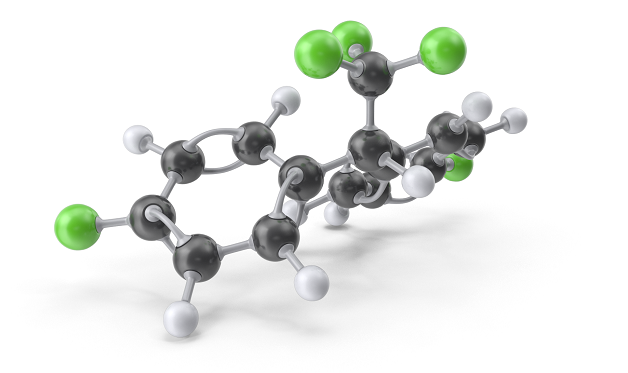
 Data Structure
Data Structure Networking
Networking RDBMS
RDBMS Operating System
Operating System Java
Java MS Excel
MS Excel iOS
iOS HTML
HTML CSS
CSS Android
Android Python
Python C Programming
C Programming C++
C++ C#
C# MongoDB
MongoDB MySQL
MySQL Javascript
Javascript PHP
PHP
- Selected Reading
- UPSC IAS Exams Notes
- Developer's Best Practices
- Questions and Answers
- Effective Resume Writing
- HR Interview Questions
- Computer Glossary
- Who is Who
What is the full form of DDT?
Introduction to DDT
Dichloro-diphenyl-trichloroethane (DDT) is the first effective chemical insecticide created in the 1940s. It was initially applied with remarkable success to cure typhus, malaria, and other ailments brought on by insects for civilians as well as soldiers.

It also did a good job of controlling pests in gardens, homes, businesses, and agriculture. Numerous bug species have developed resistance to DDT due to its early effectiveness and extensive use as a pesticide in the US and other countries.
Chemical composition of DDT
Chemically speaking, DDT is a compound with the formula?14?9??15. This chemical substance, which belongs to the class of organic halogen compounds, is an artificial insecticide that exists as a flavorless and colorless crystalline solid at standard temperature and pressure, or STP. It behaves as a contact toxin that supposedly disturbs the nervous system to create its effects and is extremely hazardous to various insects.
In 1874, chloral and chlorobenzene were first mixed with sulfuric acid to make DDT.
It is extremely hydrophobic in nature and insoluble in water and soluble in the majority of organic solvents like fats and oils.
The insects that live on the crops are exposed to DDT if crops are sprayed with it. In the end, the insect dies because it suffers nerve damage.
Historical uses of DDT
Under the direction of Adolf von Baeyer, Othmar Zeidler created DDT for the first time in 1874. It was further discussed in 1929 in a dissertation by W. Bausch and two additional publications in 1930. The Swiss scientist Paul Hermann Müller, who received the 1948 Nobel Prize in Physiology and Medicine for his work, did not discover DDT's insecticidal qualities until 1939.
Contemporary issues related to DDT
DDT is probably consumed by people through food, including dairy, fish, and meat. DDT exposure can occur through ingestion of food, inhalation, or contact with DDT- contaminated objects. DDT and DDE can change into one another and linger in the environment and on people.
Many worries about the environment and human health have been brought up by the unchecked use of DDT. Every living thing on Earth is believed to be exposed to DDT, which is primarily stored in body fat. This is because DDT is regarded as being omnipresent. Dietary sources account for the majority of exposure to DDT and its metabolites.
The effects of DDT exposure on human health at low levels in the environment may not be obvious. After exposure to high concentrations, people may experience vomiting, convulsions or nervousness, and seizures. Animals used in the lab showed impacts on liver function and reproductive health.DDT is viewed as a possible human carcinogen.
Its use is still employed in some developing nations for crucial public health objectives even though it has been restricted in the majority of countries due to environmental concerns, primarily due to its detrimental effects on wildlife, and it continues to be manufactured for export As a result of its durability and ability to accumulate in adipose tissue, DDT is currently present in every living thing on the earth, including human tissues.
Egg breaking and embryo deaths occur in several bird species because of eggshell thinning and low rates of reproduction.
Humans, who are at the top of the food chain, get DDT through food crops that were treated with chemicals in the field. DDT also builds up in the fat of animals like fish and mammals that have also been exposed to it in the environment. The DDT has subsequently transferred up the food chain.
The term bioaccumulation refers to the fact that DDT levels gradually increase over time in people and larger predatory species, particularly meat-eating raptors like eagles, hawks, etc.
Conclusion
Pesticide dichlorodiphenyltrichloroethane was once commonly employed to manage agricultural pests and insects that spread diseases like malaria. DDT is an inert, tasteless, odorless, white, crystalline substance. Its use was declared illegal in the United States in 1972 due to wildlife harm, but it is still employed in certain other nations. Chemicals like DDT that contaminate commercial DDT preparations include DDE or dichlorodiphenyldichloroethylene) and DDD (dichlorodiphenyldichloroethane). DDE has no usage in the industry.
FAQs
Q1. What does pure DDT involve?
Ans: The commercial product, which typically contains 65 to 80 percent active ingredients along with related chemicals, is an amorphous powder with a lower melting point. Pure DDT is a colorless, crystalline solid that melts at 109° C . DDT can be applied as a spray, dust, or aqueous suspension.
Q2. Why was DDT once widely used?
Ans: A wartime discovery that would make schools, restaurants, hotels, and houses more comfortable, pest-free locations for humans and their pets. It would also safeguard battlefield gardens, agricultural produce, and livestock from infestations. DDT was a toxin, but it was acceptable for use in battle.
Q3. Is DDT still in use today?
Ans: DDT is still produced in the US and is widely dispersed over the world even though it is illegal to use DDT as a pesticide in the US, barring a public health emergency. DDT is present in several locations containing hazardous waste, and it can be a source of exposure.

